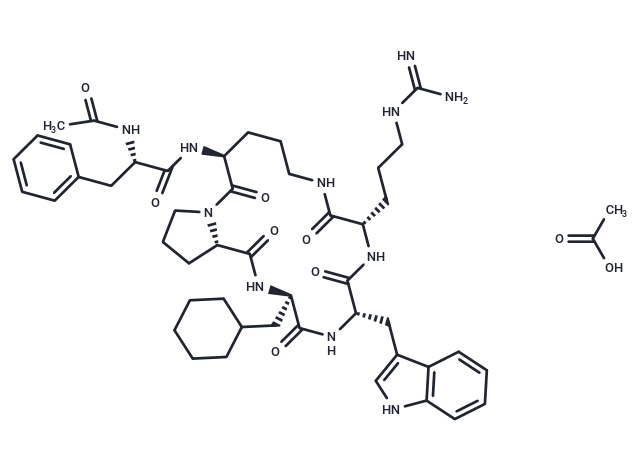Shopping Cart
- Remove All
 Your shopping cart is currently empty
Your shopping cart is currently empty
PMX-53 is a potent and orally active CD88 (C5aR) antagonist (IC50: 20 nM) and inhibits C5a-induced neutrophil myeloperoxidase release and chemotaxis with IC50 values of 22 nM and 75 nM, respectively. PMX-53 is also an agonist of Mas-related gene 2 (MrgX2).

| Pack Size | Price | Availability | Quantity |
|---|---|---|---|
| 1 mg | $113 | In Stock | |
| 5 mg | $258 | In Stock | |
| 10 mg | $382 | In Stock | |
| 25 mg | $592 | In Stock | |
| 50 mg | $816 | In Stock | |
| 100 mg | $1,090 | In Stock | |
| 200 mg | $1,480 | In Stock | |
| 1 mL x 10 mM (in DMSO) | $398 | In Stock |
| Description | PMX-53 is a potent and orally active CD88 (C5aR) antagonist (IC50: 20 nM) and inhibits C5a-induced neutrophil myeloperoxidase release and chemotaxis with IC50 values of 22 nM and 75 nM, respectively. PMX-53 is also an agonist of Mas-related gene 2 (MrgX2). |
| In vitro | In HMC-1 cells, PMX-53 (10 nM) inhibits C5a-induced Ca2+ mobilization, but at higher concentrations( ≥30 nM) it causes degranulation in LAD2 mast cells, CD34+ cell-derived mast cells, and RBL-2H3 cells stably expressing MrgX2. Replacement of Trp with Ala and Arg with dArg eliminates the ability of PMX-53 to inhibit C5a-induced Ca2+ mobilization in HMC-1 cells and to cause degranulation in RBL-2H3 cells expressing MrgX2[1]. |
| In vivo | Local pretreatment of rats with PMX-53 (60-180?μg per paw) inhibits zymosan-, carrageenan-, lipopolysaccharide (LPS)- and antigen-induced hypernociception[2]. Pharmacokinetic analyses demonstrate that PMX-53 appears in the plasma within 5 min of oral administration (3 mg/kg) to rats, with peak blood levels of approximately 0.3 μM being reached within 20 min. The plasma elimination half-life was approximately 70 min in this case[3]. |
| Molecular Weight | 956.16 |
| Formula | C49H69N11O9 |
| Cas No. | 852629-88-0 |
| Smiles | N=C(N)NCCC[C@@H]1NC([C@H](CC2=CNC3=C2C=CC=C3)NC([C@@H](CC4CCCCC4)NC([C@H]5N(C([C@H](CCCNC1=O)NC([C@H](CC6=CC=CC=C6)NC(C)=O)=O)=O)CCC5)=O)=O)=O.CC(O)=O |
| Relative Density. | no data available |
| Color | White |
| Appearance | Solid |
| Sequence | Ac-Phe-Orn(1)-Pro-D-Cha-Trp-Arg-(1) |
| Storage | keep away from moisture | Powder: -20°C for 3 years | In solvent: -80°C for 1 year | Shipping with blue ice/Shipping at ambient temperature. | ||||||||||||||||||||||||||||||||||||||||
| Solubility Information | H2O: 95.6 mg/mL (99.98 mM), Sonication and heating are recommended. DMSO: 125 mg/mL (139.49 mM), Sonication is recommended. | ||||||||||||||||||||||||||||||||||||||||
Solution Preparation Table | |||||||||||||||||||||||||||||||||||||||||
H2O/DMSO
DMSO
| |||||||||||||||||||||||||||||||||||||||||

Copyright © 2015-2025 TargetMol Chemicals Inc. All Rights Reserved.